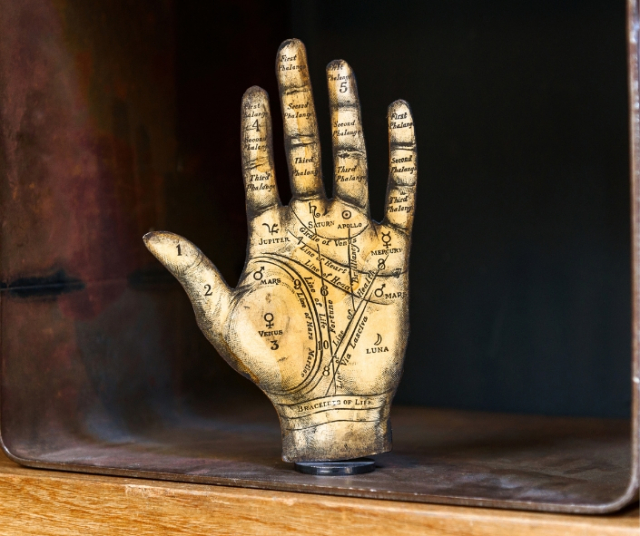Palm reading, also known as palmistry, is an ancient practice that has captured the imagination of people throughout history. It is believed that the lines and marks on our hands can reveal secrets about our past, present and future. Although some see it as a form of entertainment, others consider it a serious tool for self-exploration and understanding of life. In this article, we will explore the fascinating tradition of palm reading, its origins, techniques, and the controversy surrounding it.
History of Palm Reading: An Ancient Art
Palmistry has deep roots in various cultures around the world. It is found in ancient civilizations such as China, India, Egypt and Greece, where wise men and mystics used their hands as a means of interpreting people's destiny. In ancient China, for example, palmistry was practiced by emperors, who believed that the lines on their hands revealed valuable information about the personality and destiny of their subjects.
In India, palmistry is associated with Vedic astrology, where the lines of the hands are considered a reflection of cosmic forces that influence a person's life. In ancient Greece, Aristotle wrote about palmistry, suggesting that hands could reveal information about a person's health and character.
Palmistry also spread in the Middle Ages, where gypsies and other nomadic groups made a living practicing it. However, during this period, the Catholic Church considered palmistry a form of witchcraft, leading to its prohibition and persecution in some places.
The Bases of Palmistry: Lines, Mountains and Fingers
Palm reading focuses on analyzing three main aspects of the hand: the lines, the mountains and the fingers. Each of these elements provides unique information about the person being read.
Lines: The main lines on the palm of the hand include the life line, the heart line and the head line. Each of these lines is associated with different aspects of life, such as health, love and intelligence. Palmistry involves examining the length, depth, and curvature of these lines to obtain more detailed interpretations.
Mounts: The mounts are the fleshy areas of the palm found under each finger. Each mount is associated with a planet and a specific quality. For example, the Mount of Venus is associated with love and sensuality, while the Mount of Jupiter is related to ambition and self-confidence.
Fingers: The shape, length and proportions of the fingers are also crucial elements in palmistry. Each finger is believed to represent different aspects of personality, such as communication, creativity and logic.
Palm Reading Techniques: An Interpretive Art.

Palmistry is not just about observing the lines and features of the hand; It also implies a deeper connection between the reader and the person whose hand is being read. Here are some common techniques used in palm reading:
General shape of the hand: The general shape of the hand, whether square, rectangular, conical or mixed, provides information about the basic nature of the person.
Skin flexibility and texture: The softness or roughness of the skin, as well as the flexibility of the joints, can indicate aspects of a person's personality and health.
Hand color and temperature: Some readers also look at hand color and temperature for clues about the person's health and emotional state.
Marks and scars: Unusual marks, scars or moles on the hands can also have specific meanings in palmistry.
Controversies and Skepticism Surrounding Palmistry
Despite its long history and popularity, palm reading has faced skepticism and criticism from the scientific community and some religious sectors. Many argue that palmistry lacks a scientific basis and that interpretations are subjective and vague.
Detractors also point out that palm readings are often vague and applicable to almost anyone. They argue that the claims made by palmists are generalizations that could apply to a wide variety of individuals, undermining the credibility of this practice.
Despite criticism, palmistry remains popular in many places around the world, and some individuals rely on palm readings as a tool for personal reflection and decision making. For them, palmistry is not only a form of entertainment, but also a means to explore their own inner self and better understand their path in life.
The Rebirth of Palmistry in the Modern Era
In today's digital age, palmistry has experienced a renaissance thanks to the availability of information online and the ease with which personal experiences can be shared. Social media and video platforms have allowed palmists to share their skills and perform readings online, reaching global audiences.
Additionally, some mobile apps offer "virtual palm readings," where users can upload images of their hands to receive automatic interpretations. Although these apps cannot match the personalized experience of a live reading, they demonstrate how palmistry has evolved with modern technology.
Beyond the Lines of the Hand.
Palm reading, with its ancient roots and continued practice in the modern era, remains a fascinating phenomenon. Whether considered as a form of entertainment or a serious tool of self-exploration, palmistry has stood the test of time.
Although science and religion may question its validity, palmistry persists as a unique expression of the connection between the past, present and future. In the end, the interpretation of the lines of the hand can be as individual as the hands themselves, and the truth behind palmistry may lie in the personal experience of those who seek answers in the curves and marks that lie in the palm of their hand. hand.






